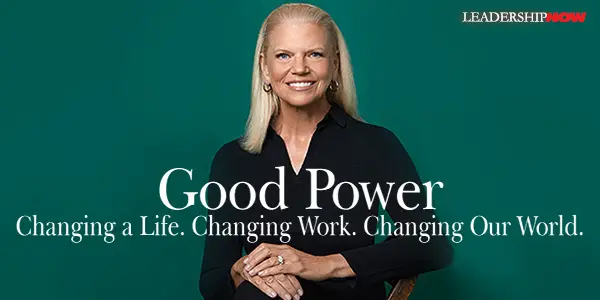 |
 |
03.06.23

Good Power: Changing a Life. Changing Work. Changing the World.
THE TIME TO THINK about power is before you get it. Power is part of leadership, and it can be used in the service of others or for personal gain. In Good Power: Leading Positive Change in Our Lives, Work, and World, former Chairman and CEO of IBM Ginni Rometty redefines power as a way to “drive meaningful change in positive ways for ourselves, our organizations, and for the many, not just the few.” Using her life experiences and lessons learned, she draws out principles that define good power. She observes that power that doesn’t produce tangible results is pointless. “Power is necessary to change things for the better, and that power can be good when it’s wielded respectfully, when it navigates tensions, and when it strives for progress over one person’s idea of perfection.” Rometty divides the book into three parts that correspond with our own journey as we grow into adulthood: the power to change me, the power to change we (a group or organization), and the power to change us as a society. She says that while some clients appreciated her perfectionist tendencies, it sometimes left her colleagues cold. “My drive for perfection often meant I only focused on what needed to change without acknowledging the positive. This could keep people from trusting themselves. It would take me a while to learn that just because I could point something out didn’t mean I should.” The soul of good power is “being in service of others,” which she differentiates from the act of “serving others.” Being in service of others is not a means to an end, but a means in and of itself. It manifests in how we act and the behaviors we choose in moments of preparation, interaction, and follow-up. Being in service of others means delivering value, which involves self-control and empathy—understanding who you are serving. Listening is a big part of that. I discovered that listening breeds knowledge, knowledge breeds creditability, and credibility earns trust that allows relationships to flourish. And when delivering bad news, use a velvet hammer. How do we do that? Speaking about tough truths in affirmative tones let critiques land constructively. So did beginning a difficult conversation by emphasizing something positive, as well as citing facts instead of opinion to support a controversial conclusion, and ending on a note of optimism and with potential solutions. When we move beyond just developing ourselves to developing others, it signals that we are transitioning from the power of me to the power of we. We grow a company when we grow its people. Being in service of others is the why and building belief is the how for bringing people on a change journey, she writes. Building belief is about moving people to embrace an alternate reality for themselves and others, and then to willingly participate in creating it. It’s the first major step if you want people to change, because they have to understand and believe in the change. When CEO Sam Palmisano stepped down at the end of 2011, there were several qualified replacements, including Rometty. The senior vice president of human resources told her, “ Ginni, if you want the opportunity to be CEO of IBM, don’t try to run for office. She says, “I translated his sage advice to mean put your focus on followership, not politics.” One of the best chapters for me was Knowing What Must Change, What Must Endure. If we want to make changes for me or the we, we must understand that certain behaviors are required to bring about certain outcomes. New thinking brings about new behavior resulting in different outcomes. We must give people the tools—the how—to change. When moments of reinvention arrive, innovating the “how” can be overlooked in favor of focusing on the “what.” Indeed it is not enough to just tell people to deliver a different outcome. We have to cocreate a new way of working, give people permission to change, and create an environment that encourages and rewards new behaviors and skills—all at scale. In any transformation, balancing the old and new is always a challenge because it is hard for people to wrestle with this tension. Even with major changes, some things don’t change. “Transforming a really large entity also means reconciling the pace of change in the market with the rate and pace of change the organization can withstand.” In addition, “once we figure out what endures, even if it must be modernized, we have a platform from which we can bridge to the future.” What doesn’t change? If an organization is to meet the challenges of a changing world, it must be prepared to change everything about itself except the beliefs on which it bases all its policies and actions. What is your foundation “upon which the hurricane of change” can happen? When there are setbacks and critics, you need to have built some resilience. Resilience results from a number of factors, but two in particular—relationships and attitude. Both are under our control. Rometty doesn’t ignore critics. She asks herself if they have legitimate points and anything she might learn from their perspective. “Critics may inform me, but they don’t define me.” To help us in applying good power to the us—society—one way is to look “at big problems as big systems to be transformed.” Thinking systematically, “good power at scale can help build belief in a movement; cocreate new solutions; let go of what’s wrong; and modernize what’s right.” 
Posted by Michael McKinney at 06:53 AM
|
BUILD YOUR KNOWLEDGE
 

How to Do Your Start-Up Right STRAIGHT TALK FOR START-UPS 
Grow Your Leadership Skills NEW AND UPCOMING LEADERSHIP BOOKS 
Leadership Minute BITE-SIZE CONCEPTS YOU CAN CHEW ON 
Classic Leadership Books BOOKS TO READ BEFORE YOU LEAD |